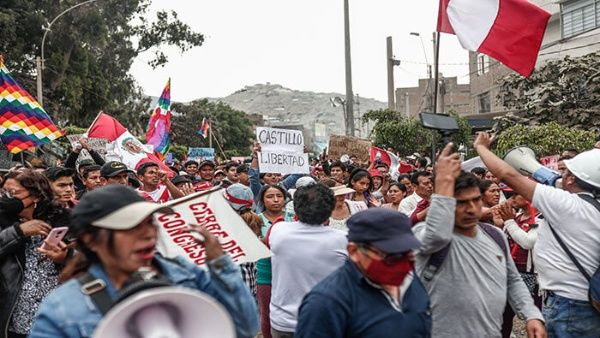
Marches and demonstrations in Peru began in early December following the dismissal of Pedro Castillo. | Photo: EFE
By María Josefina Arce
Peru is caught in political and social instability. Protests against the government of President Dina Boluarte, which have been strongly repressed by the police and the army, have not ceased and have so far left fifty people dead and numerous wounded and arrested.
Peruvians have not left the streets since last December 7, when Pedro Castillo was removed from his position as head of state by the Congress, arrested shortly after by the police and who remains in prison on charges of rebellion, after having announced the dissolution of the legislative body and called for the election of a Constituent Assembly.
Sworn in as president a few hours after the removal of the legitimate president, Boluarte's resignation is demanded by the demonstrators, who are also demanding the resignation of the Congress, an early election in the country, the establishment of a Constituent Assembly and the release of Castillo and other detainees.
Although in a recent speech the current president apologized to the Peruvian people for the situation and the deaths in the demonstrations, her latest steps are going in the opposite direction of the peace and tranquility that she said her government seeks. The reality is that she has radicalized her policy of persecution and does not listen to the demands of the Peruvian people. Seven social leaders were arrested in the city of Ayacucho in recent days.
Moreover, Boluarte, who has made it clear that he will not leave power, suspended constitutional rights for 30 days in several regions of the country. The inhabitants of Lima, Callao, Puno and Cusco woke up this Sunday in a state of emergency, just when new protests were called for this week.
The government decree authorizes the military forces to intervene together with the police to supposedly protect public order.
The truth is that since Castillo announced his candidacy for the elections of April 2021, the right wing was on guard, from that moment the rural teacher was in the spotlight and finally became a victim of the oligarchy's coup.
With more than 50% of the votes he triumphed at the polls in the second round of the elections, held on June 6. But he had to wait more than a month for his victory to be declared, in view of the false accusations of alleged fraud made by his opponent, the right-wing Keiko Fujimori, of Fuerza Popular.
On July 28 he took office and from then on the oligarchy did not give the new president a break. In a year and a half of his mandate he was unable to govern.
Castillo was forced to change ministers in his executive, given the pressures of a Congress in the hands of the right wing. Before the fabricated motion of vacancy that led to his removal triumphed, he had already been subject to two such processes.
The first was in December 2021, a few months after becoming president, but was not admitted. The second was in March 2022 and only received 55 votes in favor, out of the 87 needed.
Peru does not manage to get out of uncertainty and political and social instability. From 2016 to date, counting Boluarte, six presidents have succeeded each other. Recent events have only aggravated the constitutional crisis in the Andean nation.

